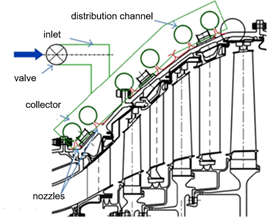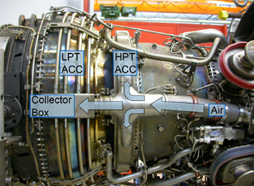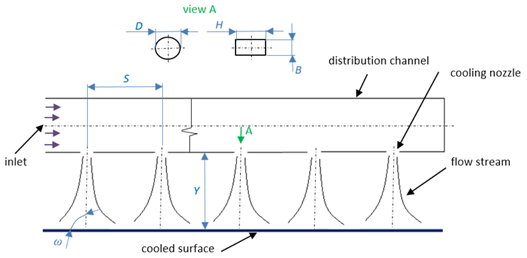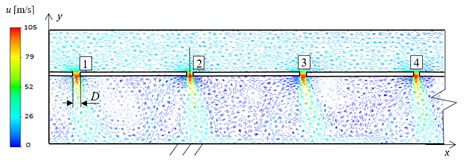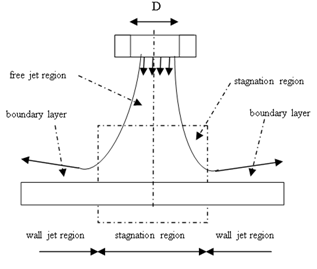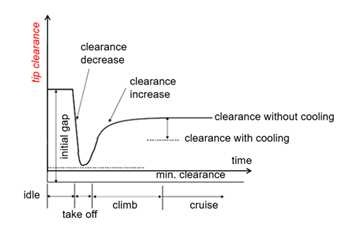Modern low-pressure turbine engines are equipped with casings impingement cooling systems. Those systems (called Active Clearance Control) are composed of an array of air nozzles, which are directed to strike turbine casing to absorb generated heat. As a result, the casing starts to shrink, reducing the radial gap between the sealing and rotating tip of the blade. Cooling air is delivered to the nozzles through distribution channels and collector boxes, which are connected to the main air supply duct. The application of low-pressure turbine cooling systems increases its efficiency and reduces engine fuel consumption.
- cooling systems
- turbine casings
- Active Clearance Control
1. Introduction
Gas path sealing is a challenging problem of aircraft gas turbine engine design. It is caused because the clearance between the blade tip (rotating structure) and casing with sealing (static structure) tends to vary during engine operation due to various mechanical and thermal loads. What is more, inertial (maneuver) and aerodynamic (pressure) loads during flight have to be taken into consideration. More factors, which also have a negative influence on tip clearance control, are manufacturing and assembly limitations such as case ovalization effects, tolerance stack-ups, shaft deflections, etc. Additionally, the clearances between blade tip and sealing vary along the lifespan of the whole engine as well as the part itself, as the wear and thermal erosion on all of the parts occur.
Despite the large number of limitations that have to be considered, low-pressure turbines are commonly equipped with impingement cooling systems, called Active Clearance Control (ACC), which help to control gas path sealing and therefore reduce gas path leakages. The main role of the impingement cooling system (to provide efficient gap control) is gap reduction between the tip of the blades and sealing during engine operation in the cruise phase. The benefits of active clearance control are, among others, increased engine efficiency, reduced specific fuel consumption (SFC), and reduced NOx and CO emissions.
An impingement cooling system comprises an array of nozzles, which direct jets of high-velocity fluid at a target surface, thus securing proper operating conditions of attached hardware (e.g., the blade tip and sealing surface) through convective heat transfer between fluid and target surfaces.
Lowering air leakage in the area of blade tips boosts turbine efficiency, making it possible for the engine to fulfill thrust and performance targets utilizing less fuel and with the lower temperature at the rotor inlet. The lifecycle of the hot section components may be increased by operating the turbine at lower temperatures, which consequently will increase the engine’s service life as a result of the greater interval between overhauls. Lattime and Steinetz [1] give overviews of multiple advantages of advanced active clearance control systems. Taking fuel savings into consideration, a reduction of tip clearance by 0.010 in. decreases specific fuel consumption by ~0.8% to 1%. A significant cut down in NOx, CO, and CO2 emissions are also achievable by reduction of fuel consumption. Exhaust gas temperature (EGT) may be lowered by ~10 °C through the reduction of tip clearances by 0.010 in. The main reason for the removal of an aircraft engine from service is the deterioration of the EGT margin. Up to 1000 extra cycles of engine on-wing time may be achieved by operating it at lower temperatures, thus increasing the life of hot sections parts. Other advantages are an increase in payload and mission range.
A certain amount of technical issues has to be focused on to field an efficient active clearance control system. Two main challenges encompass the high-temperature environment and the necessity for precise control.
2. Basic Design Principle
The impingement cooling systems comprise one or more distribution channels, every one of which comprises an adequate number of cooling nozzles directed at the target surface at a specified angle, see Figure 1. Air is supplied to the distribution channels via an inlet tube. The valve regulates air flow, which feeds the ACC system. The aim of an impingement cooling system is to decrease the radial gap between the tips of rotating blades and the sealing.
Figure 1. Schematic section of low-pressure turbine equipped with Active Clearance Control (ACC) [2].
Figure 2 depicts the typical cooling system of low and high-pressure turbine casing of turbofan engine.
Figure 2. Typical tube design of the ACC Cooling system of low-pressure (LP) and high-pressure (HP) turbines [3].
The depicted low-pressure turbine cooling system is built of a number of tubular distribution channels at a distance to the casing surface. Each of the distribution channels comprises an appropriate number of holes, through which the air flows at high velocity and onto the surface of the casing. The role of the cooling medium is ensuring a proper heat exchange through convection with the casing heated up as a result of hot gas flow occurring in it. A various number of nozzles and, therefore, a various amount of coolant is employed in different circumferential regions along the engine axis according to the local casing temperature.
Higher temperature gas flows through the front part of the casing (with a smaller diameter) due to the proximity of the combustion chamber.
The decrease of temperature of casing, to which a number of rows of sealing are attached, results in a decrease of tip clearance between rotating and static components.
The air is delivered to distribution channels through collector channels, which are connected to the main air supply duct, which in turn provides air to the cooling system of a low-pressure turbine. In the typical low-pressure turbine casing cooling systems, the distribution channels are connected with collector channels by welding. The whole system is mounted on brackets distributed circumferentially, which in turn are fixed to the casing.
The cross-sections of the flow channels are selected in a way that minimizes the linear pressure losses in the flow of the cooling medium. Additionally, the geometrical shape of flow channels limits the generation of local pressure losses during the operation of the system.
The crucial aspect of impingement cooling systems design is ensuring a proper clearance between casing’s and cooling systems’ components to guarantee that thermal stresses, which occur during engine operation, are compensated for. These stresses are a result of, among others, various operating temperatures of particular components and various heat expansion coefficients of applied materials.
The next decisive feature of impingement cooling systems design is the utilization of materials, which guarantee proper operation of components in high temperature and an increased pressure related to the flow of cooling fluid.
The dynamic stresses generated, e.g., due to the turbine shaft’s imbalance, are also significant factors. These stresses may lead to damaging of the parts of a cooling system in the areas of increased concentration of stress (e.g., weld seam areas).
The air, which is fed to the cooling systems, is transported from the turbofan engine’s bypass airflow. The mass output of air is governed by a valve. In cooling systems’ construction, it is crucial that the cooling nozzles are positioned at an adequate distance to the cooled target surface and that they are aimed at an appropriate angle, which ensures an effective heat exchange between the cooling medium and the casing.
The result of the operation of a cooling system is an increase of kinetic energy of gases being burnt, which is converted into mechanical energy of a rotating shaft. Impingement cooling systems are applied both to the cooling of high and low-pressure turbines of turbofan engines [4]. Cylindrical [5,6] and slot [7,8] nozzles are often used in the construction of cooling systems. The main parameter that is characteristic for the cylindrical nozzle is its diameter D, and for the slot nozzle—the length of slot H. The primary parameters, which are characteristic for the impingement cooling systems, are dimensionless coefficients Y/D, H/B, and S/D. They are depicted in Figure 3.
Figure 3. Impingement cooling systems distribution channel’s axis cross-section.
Relative distance Y/D determines the ratio between the distance of the nozzle and a target cooled surface Y and the nozzle diameter D, H/B determines the relationship between the slot lengths H to the sloth width B. The relative distribution of nozzles S/D determines the ratio between the distances between the neighboring nozzles’ axes S to the nozzle diameter D. The cooling efficiency is additionally affected by, among others, the angle ω between the nozzle and the cooled target surface, the sort of cooling medium and Reynolds number Re.
The impingement cooling systems are also divided according to the possibility of fluid flow between the cooled surface and the surrounding environment. There are cooling systems in which the cooling medium flows parallel to the cooled surface before leaving the system [6,8], and systems in which the stream of cooling medium flows out of the system immediately after coming in contact with the cooled target surface [9,10].
In impingement cooling systems, a “fountain effect” [11], which is cooling medium recirculation, occurs due to neighboring streams’ collisions. Figure 4 depicts an example of velocity vectors distribution in the x-y plane in the area of four nozzles of the cooling system, which shows the effect of fountain generation as a result of collisions of neighboring fluid streams.
Figure 4. Distribution of velocity vectors in the x-y plane in the area of four cooling nozzles depicting the generation of fountain effect [11].
The flow field through a single nozzle is characterized by the existence of the nozzle area, stagnation area, and wall area (Figure 5). The flow of impinging jet goes through a number of specific areas, as pictured in Figure 5. The jet comes out of a nozzle or aperture at a temperature and velocity profile and turbulence characteristics determined by the upstream flow. Considering a pipe-shaped nozzle, also known as a tube or cylindrical nozzle, the flow is established into a parabolic velocity profile characteristic to pipe flow, and a mild amount of turbulence is generated upstream. On the contrary, a flow conveyed by the application of differential pressure traversing a space of a thin, flat orifice will generate a starting flow with a quite flat velocity profile, lower turbulence, and a downstream flow contraction (vena contracta) [11].
Figure 5. Characteristics of flow through a single nozzle.
3. ACC Operation Rationales
The function of an ACC is to provide proper clearance between the tip of the blade and sealing during the entire engine operation. There are several distinct stages in the flight cycle, which translate directly to engine conditions—the schematic cycle is shown in Figure 6.
Figure 6. Tip clearance control [12].
The tip clearance at the ground idle condition, in which the engine is free spinning on the ground, is constant as no significant centrifugal force acts on the rotating part, and thermal loads also do not appear.
After taxing to take-off condition, the throttle is applied. The temperature change ratio is highest in this condition. Core flow (the air, which flows through all stages of a compressor into the combustion chamber, is then mixed with fuel and burnt to flow through the turbine and into the exhaust area) heats the inner (core) part of the engine at a very high rate. Additionally, the centrifugal force increases with the rising engine’s rotational speed and starts acting on the rotating components. The combination of these factors causes the blade tip with sealing fins to displace outwards. On the other hand, the casing is heating up at a much slower rate, as it is much further away from the hottest core flow. The sum of these two displacements results in gap closure and leads to achieving a minimum clearance value. In this condition, the flow efficiency is at its best, as the leakages of hot core flow are lowest, thus transforming the maximum amount of aerodynamic energy acting on turbine blades into the rotational speed of the shaft.
Following is the climb condition, during which the casing heats up continually to reach its ADP (aero design point) condition—the state designed for the cruise of an aircraft. Tip clearance in these conditions increases as the casing expands due to rising temperature. After reaching cruise condition, a gap is established at ADP. Active clearance control executed through impingement cooling system allows reducing the tip clearance by cooling down the casing (using bypass air), which is corresponding to the rightmost section of the graph in Figure 6.
4. Heat Transfer between Casing and Air Stream from ACC
The heat transfer process between the hot casing and cooling air distributed via impingement cooling nozzles is characterized by dimensionless Nusselt number Nu. This number is a basic parameter, which determines the cooling efficiency of the wall by the air stream. Its value characterizes heat flow intensity on the boundary between fluid and wall [10,13]. The Nusselt number is directly proportional to heat transfer coefficient h, which in turn is dependent on the temperature difference between the wall (Tw) and fluid temperature (Tj). The value of Nusselt number Nu is given by the equation:
where:
h—heat transfer coefficient on the fluid-wall boundary;
D—cooling nozzle diameter;
k—heat conduction coefficient of the fluid;
Heat transfer coefficient h is given by the equation [14]:
where:
Tw—wall temperature;
Tj—nozzle temperature;
∂T/∂y—derivative of temperature in the direction perpendicular to the cooled surface.
To define heat transfer rates between the target plate and the coolant line, the averaged Nusselt number (3) and area-averaged Nusselt number (4) have to be evaluated.
Line averaged Nusselt number [15]:
where:
L—averaging line parallel to the target plate;
Nu (x)—local Nusselt number along line L;
Area averaged Nusselt number [15]:
where:
A—averaging area parallel to the target plate;
Nu (x,y)—local Nusselt number on area A;
The other dimensionless parameters describing heat transfer between target plate and cooling fluid are:
- nozzle height to nozzle diameter (H/D);
- distance between nozzle and target plate to nozzle diameter (Y/D);
- distance between neighboring nozzles to nozzle diameter (S/D);
- distance from jet axis to nozzle diameter (r/D);
- Reynolds number according to the following expressions:
where:
Uo—mean nozzle velocity at the exit area;
υ—kinematic viscosity of the cooling fluid;
- Mach number based on nozzle exit average velocity (for the Ma < 0.3, there is a negligible impact on heat transfer rates)
The heat transfer rates between the target surface and cooling fluid and thus cooling efficiency also depends on the shape of the nozzles. Paper [16] shows numerical analyses of the influence of various nozzle shapes (cylindrical, convergent, divergent, and cylindrical elongated) on Nusselt number distribution along plate cooled with one row of ten nozzles. The highest average value of the Nusselt number was obtained for the cylindrical ones.
In turn, Marzec, K. [17] showed numerical analyses of the influence of various nozzle positions on the Nusselt number distribution of an array of ten cooling orifices placed along the non-planar target surface. Results presented in this paper determine the most optimum position of the cooling nozzles (up to two orifice diameters) to provide a high rate of heat transfer for seven various dimensionless jet positions.
Besides presented parameters, heat transfer between target plate and cooling fluid depends mostly on turbulence intensity, Reynolds number, and Mach number (negligible influence for Ma < 0.3).
To evaluate the stream of nozzle mass flow, the discharge coefficient has to be considered. Discharge coefficient (Cd) is a ratio of the real mass flow rate through the orifice in relation to the isentropic flow rate. This coefficient includes losses (pressure, friction), which reduces the mass flow rate through a nozzle. The ideal mass flow is calculated assuming a one-dimensional isentropic expansion through an orifice from coolant pipe (secondary flow) total pressure (Pt) to the main flow (primary flow) static pressure (Pd) with the obtained expression:
where:
—real mass flow rate;
γ—heat coefficient ratio;
R—gas constant;
Pt—total pressure;
Pd—static pressure;
Tt—total temperature.
Active clearance control systems consist of a number of nozzles placed in an array. For low values of Y/D and low values of S/D, the flow delivered by each nozzle (due to limited space to leave impingement region) forms a crossflow with the neighboring flow. The presence of the crossflow causes asymmetric nozzle flow area, moves stagnation points, and results in a thicker boundary layer. These effects have a negative impact on average heat transfer rates. The presented nozzle interference does not have a significant influence on the peak of the Nusselt number value; however, the averaged value shows a decrease [15].
Another behavior affecting heat transfer rate between coolant and target surface is thermal interaction of the hot spent impingement flow coming out from the upstream (after striking target surface) with the downstream nozzle fresh coolant. This phenomenon has a negative impact on heat transfer rate and depends mostly on Y/D and S/D factors.
5. Review of Basic Geometrical and Physical Cooling Systems’ Parameters
The research described in the literature takes into consideration both geometrical and physical parameters, which characterize the operation of impingement cooling systems.
Various cooling systems nozzles diameters D are considered [2,18,19]. The paper [2] includes a numerical analysis of impingement cooling system with seven different values of cooling nozzles’ diameters: D = 0.45 mm; D = 0.5 mm; D = 0.64 mm; D = 0.8 mm; D = 1.6 mm; D = 2.4 mm; D = 3.2 mm. The highest mean values of Nusslet number (Nu) were achieved in the case of a nozzle with diameter D = 3.2 mm and Mach number Ma = 0.1. For comparison, the paper [12] describes the research on cylindrical nozzles with larger diameters D = 6 mm, D = 7.3 mm, D = 10 mm, and D = 15 mm respectively. The analysis of incompressible fluid flow shows that the highest values of Nusselt number (Nu) were achieved for a value of coefficient Y/D = 6 and for a nozzle diameter D = 15mm. The performed research showed that the application of nozzles with higher diameter D in cooling systems has an influence on the increase of the amount of heat being transferred on the fluid-wall boundary.
San et al. [5] performed research with an aim to determine the influence of relative distance Y/D and Reynolds number (Re) on the distribution of Nusselt number along the cooled surface. The values taken for the research were: Re = 10,000, Re = 15,000, Re = 30,000 and Y/D = 1, Y/D = 2, Y/D = 4, and Y/D = 6. Results of the research indicated cooled areas characterized by the occurrence of local maximum of the Nusselt number, among others, for Y/D = 1 and Reynolds number Re = 30,000. This research demonstrates a major influence of both relative distance Y/D and Reynolds number Re of the flowing fluid on the cooling efficiency.
Trinh et al. [20] showed experimental research of three kinds of nozzles: tube-shaped, cylindrical, and cross-shaped nozzles placed on a hemisphere. In the results of the research presented, the highest value of Nusselt number on the boundary of the fluid-wall area was achieved when the cylindrical nozzle was applied, and the lowest values were observed for the cross-shaped nozzle.
The cooling efficiency is additionally affected by the angle of inclination of the nozzle to the cooled surface ω [21–23]. Taking a three-dimensional problem into consideration, the change of angle of inclination of the nozzle to the cooled surface results in forming of elliptical distribution of Nusselt number on the cooled surface [10]. For comparison, in the case of the nozzles directed perpendicularly to the cooled surface, the distribution of Nusselt number on the cooled surface is cylindrical. Afroz and Sharif [19] showed various inclination angles of nozzle ω to the cooled surface have been examined at two values of Reynolds number: Re = 23,000 and Re = 50,000. The value of Nusselt number decreased by 25%–50% with a decrease of angle from ω = 90° to ω = 45° for the given values of Reynolds number (Re). Moreover, when angle ω > 50° and the Re = 50,000, the occurrence of the “Coand effect” was observed. This phenomenon is characterized by the tendency of the fluid stream to adhere to the neighboring surface. When the angle of inclination of the nozzle to the cooled surface is low, the fluid stream starts to adhere to the adiabatic wall of the fluid distribution channel positioned nearby. At a Re of 23,000, it was possible to observe the Coand effect for an angle ω > 30°. This effect leads to a drastic decrease in surface cooling efficiency. In the literature, the phenomenon of fountain effect created as a result of the collision of neighboring streams of cooling fluid is also described [24]. In such a case, recirculation of fluid occurs. The paper [24] shows, that when the relative distribution of nozzles acquires a value S/D < 4, the fluid recirculation as a result of collisions of neighboring streams occurs. The authors prove, that if Y/D = 2, then the collisions of neighboring streams occur when S/D ≤ 10. The maximum value of Nusselt number along the cooled surface has been achieved at S/D = 8. San and Lai [25] confirmed that at S/D = 14, no interaction between neighboring streams occurs.
The presented results of the literature research show the broad differentiation of operation parameters of impingement cooling systems. The increase of flow velocity of fluid stream represented by Re number causes the increase of heat exchange efficiency between the fluid and cooled surface.
The temperature difference between the cooled surface and a cooling fluid stream, nozzle inclination angle, and geometrical shape of it is also of high significance.
6. Numerical and Experimental Methods of ACC Researches
Researches focused on flow behavior and the heat transfer process of the impingement cooling systems are divided into two categories: numerical modeling [26–28] and experimental researches [29,30]. Both categories are analyzing possible ways of ACC efficiency improvement. Experimental results are often used to validate numerical methods used for the calculations of ACC performance.
Experimental researches on impingement cooling systems are focused mostly on measuring the surface heat transfer coefficients. In such experiments, arrays of nozzles drilled in distribution tubes are installed above a target surface (flat, cylindrical, or conical) with spacers. The air supply setup consists of a pump, air reservoir, dryer, filter, and a control valve to regulate pressure and mass flow. The target surface is often supplied with constant heat flux ( ) using thin steel strips bonded to the target plate. To reduce lateral heat transfer within the target plate, low thermal conductivity materials are chosen for the target plate. The idea of this approach is to ensure that electrically generated energy is taken over by the fluid in the direction perpendicular to the target surface with constant heat flux. The temperature distribution on the backside of the target plate (Tw) is measured with non-contact optical devices such as infrared (IR) thermography cameras or thermochromic liquid crystals that change their color with the temperature. The surface heat transfer coefficient (h) is calculated with the equation [10]:
The flow temperature is often measured using thermocouples inside the distribution tubes in a location corresponding to the central nozzle, while the ambient temperature is also recorded on both sides of the target plate in order to evaluate heat losses [31].
Experimental measurements allow investigating the influence of various geometrical (nozzle diameter, shape, Y/D, S/D, etc.) and thermo-flow parameters (heat flux, Reynolds number, etc.) on the heat transfer performance of the impingement cooling system. Numerical researches of impinging cooling systems allow the assessment of the heat transfer coefficient, Nusselt number distribution, pressure drops, velocity fields, and temperature distribution for a given flow in advance of manufacturing the hardware.
Impingement cooling systems applications (ACC) to reduce the radial thermal growth of a casing involve turbulent flow downstream of the nozzles. Accurate prediction of the behavior of turbulent flow downstream the nozzles is a big challenge in numerical modeling. Finite volume and finite element computational fluid dynamics (CFD) solvers (which solve Navier–Stokes equations) are often used to evaluate the behavior of the flow and heat transfer of the impinging cooling systems. The accurate predictions of velocity fields, pressure drops, or heat transfer coefficients using CFD methods depend strongly on the modeling of turbulence and the interaction of the turbulent flow field with the target surface. The numerical approach (validated by the experimental procedure in advance) gives a chance to evaluate flow behavior and heat transfer rates for various geometries of the cooling system and target plate without limitations that can occur for the experimental procedures.
Numerical methods give an opportunity for further development of the impingement cooling systems efficiency in terms of very precise adjustment of tip clearance across the different engine operating conditions and mainly during cruise operation. The current trend in increasing the engine bypass ratio to enhance the propulsive system efficiency pushes the limits of ACC traditional design performance. It is caused in most designs by feeding air for the active clearance control (ACC) system of the LPT comes from secondary bypass flow [32]. In fact, the fan pressure ratio tends to fall, thus reducing the pressure ratio on the ACC inlet piping. Therefore impingement cooling systems require more efficient heat transfer between the casing and cooling liquid to ensure adequate tip control between rotating structure and sealing. Reduced inlet pressure, thus reduced Reynolds number requires to be compensated by modification of geometrical parameters (dimensionless nozzle-target distance Y/D, smaller pitch distance S/D, etc.) to keep the efficiency of the system on the proper level. In turn, reducing nozzle-target distance brings the risk of cooling system interference with casing during engine operation due to vibratory stresses, dynamic loads, etc. This fact has to be taken into consideration during ACC components design, especially when manufacturing tolerances are defined. Reduced nozzle-target distance with a defined chain of tolerances has to ensure that in the worst-case scenario, there is no interference between the casing and cooling system. In turn, this approach requires very precise machining and measuring tools, which makes ACC design more expensive.
7. Conclusions
Impingement cooling systems play a significant role in many technical applications, especially in the aero industry (Active Clearance Control systems). Due to the adjusted amount of cooling air directed onto the turbine casing surface, they are able to control clearance between the blade tip (rotating structure) and casing with sealing (static structure). This clearance tends to vary during engine operation due to various mechanical, thermal, inertial (maneuver), and aerodynamic (pressure) loads.
The radial clearance closure is a function of physical parameters like impingement flow, Reynolds number in the orifice region, or turbulence intensity. Nozzle diameter, dimensionless factors like relative distance Y/D, relative nozzle position S/D, the shape of the orifices, or inclination angle also have a significant influence on heat transfer rates along the cooled surface
The surrounding environment also has an impact on the heat transfer rate. Cooling systems in which the cooling medium flows parallel to the cooled surface before leaving the system (confined) are less efficient (due to the heat accumulation) in comparison to the systems in which the stream of cooling medium flows out of the system immediately after coming in contact with cooled target surface (unconfined).
Manufacturing feasibility and assembly limitations such as case ovalization effects, tolerance stack-ups, or shaft deflections also have to be considered during the design of a dedicated Active Clearance Control system.
The application of turbine cooling systems (ACC) helps to increase engine efficiency, reduce specific fuel consumption (SFC), and reduce NOx and CO emissions.

